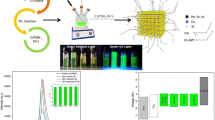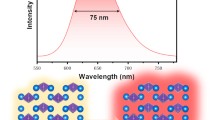Abstract
New experimental results are presented that describe the role of oxygen centers on structural lattice defects in the optics of A2B6 compounds. It is shown for the first time that that these formations contain unusual D–A pairs with an isoelectronic impurity OS. Using the methods of optical control of microcathodoluminescence spectra, the features of the distribution of oxygen in crystals have been studied. The emission and absorption spectra of self-activated CdS, ZnS, and ZnSe crystals are analyzed on the basis of modern concepts of the band anticrossing theory. In the region of the fundamental absorption edge in the central part of the homogeneity region of these crystals with different known oxygen contents, bands of the same type of complex emission spectra were identified. Various types of edge glow are revealed. The connection between the edge emission and a localized exciton at stacking faults has been confirmed. For the first time, the nature of two types of p-type ZnSe edge emission has been refined using a unified model. New data are presented confirming the role of temperature for the manifestation of exciton luminescence of the base or the glow of oxygen segregations on stacking faults. The results obtained make it possible to elucidate the compositions of crystals and combinations of defects in A2B6 crystals, which determine their stable state for use in optoelectronics.










Similar content being viewed by others
Notes
The formation of stacking faults (SFs) that segregate oxygen complexes determines the compensation of deformations in the bulk of the entire crystal and the oxygen concentration at SF ~ 1020 cm−3 [4].
A typical microstructure of samples with such SFs is shown in Fig. 8a.
For CdS Aex at 100 and 300 K, we will take as 504,7 nm (2,4565 eV) and 488 nm (25396 eV), respectively [3].
Such complexes, created mainly due to the forces of deformation interaction [23], actually represent donor-acceptor pairs that include oxygen as an isoelectronic acceptor OS* (with an effective negative charge).
The spectral position of Aex for ZnSe at 300 K corresponds to 451 nm [3].
References
N D Danilevich Ph.D. Thesis (Moscow Power Engineering Institute, Russia) (2011)
M Aven and D Prener Physics and Chemistry of AIIBVI Compounds (Moscow: Mir Press) (1970)
K A Dmitrienko, L V Taranenko, S G Shevel and A V Marinchenko Journal Physics and Technique of Semiconductors 19 788 (1985)
N K Morozova New in the optics of II-VI-O compounds. (Riga, Latvia, LAP LAMBERT Academic Publishing) (2021)
R Triboulet and P Siffert CdTe and related compounds; physics, defects, hetero- and nanostructures, crystal growth surfaces and applications (Oxford: Elsevier Press)) (2010)
I Avetissov and E Mozhevitina Res. Technol. 50 115 (2014)
N K Morozova and I I Abbasov Journal Physics and Technique of Semiconductors 56 463 (2022)
К Akimoto Rev. B. A39 3138 (1989)
N K Morozova and V A Kuznetsov Zinc sulfide (Preparation and optical properties), (eds). by M.V. Fock. (M. Science) (1987)
V I Oleshko, S S Vilchinskayaa and N K Morozova Semicond. 55 531 (2021)
W Walukiewicz et al. Rev. Lett. 85 1552 (2000)
W Shan, W Walukiewicz, J W Ager III, E E Haller, J F Geisz and D J Friedman Rev. Lett. 82 1221 (1999)
Jingbo Li and Su-Huai Wei Phys. Rev. B. 73 041201(R) (2006)
W Shan, W Walukiewicz and K M Yu Phys. Lett. 83 299 (2003)
M A Mayer and K M Yu J. Appl. Phys. 111 113505 (2012)
D A Mideros Ph.D. Thesis (Moscow Power Engineering Institute, Russia) (2008)
N K Morozova and I I Abbasov Int. J. Mod. Phys. B 36 2250136 (2022)
N K Morozova and I N Miroshnikova Semicond. 54 102 (2020)
N K Morozova, I I Abbasov, E M Gavrishchuk, M A Musaev, J I Huseynov and A J Mammadova Journal Physics and Technique of Semiconductors 56 80 (2022)
N K Morozova, A A Kanakhin and A S Shnitnikov Semicond. 50 849 (2016)
N K Morozova, V G Galstyan, A A Kanakhin and I N Miroshnikova Semicond. 47 1018 (2013)
A A Kanakhin Ph.D. Thesis (Moscow Power Engineering Institute, Russia) (2015)
N K Morozova Spectrosc. 37 1116 (1974)
N K Morozova et al. J. Inorg. Mater. 38 552 (2002)
N K Morozova, I N Miroshnikova and V G Galstyan Semicond. 53 784 (2019)
N K Morozova, I A Karetnikov, K V Golub, E M Gavrishchuk and E V Yashina J. Inorg. Mater. 40 1138 (2004)
N Yudin, O Antipov, S Balabanov, I Eranov, Y Getmanovskiy and E Slyunko Ceramics 5 459 (2022)
V A Antonov et al. Laser Phys. Lett. 20 045802 (2023)
Author information
Authors and Affiliations
Corresponding author
Additional information
Publisher's Note
Springer Nature remains neutral with regard to jurisdictional claims in published maps and institutional affiliations.
Rights and permissions
Springer Nature or its licensor (e.g. a society or other partner) holds exclusive rights to this article under a publishing agreement with the author(s) or other rightsholder(s); author self-archiving of the accepted manuscript version of this article is solely governed by the terms of such publishing agreement and applicable law.
About this article
Cite this article
Morozova, N.K., Abbasov, I.I. Luminescence due to oxygen at structural defects in A2B6 crystals. Indian J Phys (2023). https://doi.org/10.1007/s12648-023-03034-x
Received:
Accepted:
Published:
DOI: https://doi.org/10.1007/s12648-023-03034-x




